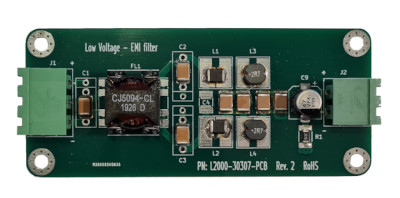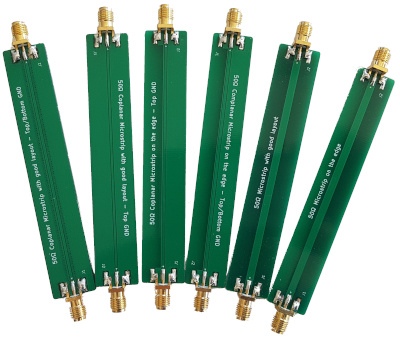Abstract
Modern electronic circuits often use high speed communication channels to enable information transfer and elaboration. Cell phones and PC mother boards could be typical system examples we use on a daily basis. Electrical signals, that must travel to the PCB to let a LED blink, do not typically drive any major concerns, but if the signal is going to use a protocol working at 1Gbits/s, the PCB traces need different considerations. The article will describe “why” and “how” to make sure the PCB can enable signal integrity along the trace, and make sure that the information is transferred correctly. Special focus will be also given to the manufacturability of the PCB.
Progetto sponsorizzato da PCBgogo
| File Type | Download File | Version | Last Update | Description | |||||
| Download | 1.0 | 14. June 2022 | Article | ||||||
Electrical signal propagation
An electrical signal represents an electromagnetic wave that propagates, in the matter of this article, on a PCB trace. The word “wave”, really means that the electric field and the magnetic field are modeled and described by the same basic equations that describe other waves we are more familiar with, such us the sounds or the waves we make on the quiet lake, by dropping a stone on it.
If we observe the waves on the water, we can see that they propagate with a decreasing amplitude, but still keeping a nice shape (signal integrity). At the time the wave reaches some obstacles on the water, the wave shape is distorted and some reflections occur. The reflections can distort our wave till the source of it. With an electrical signal analogy, we are jeopardizing the signal integrity because of the reflections.
The waves can propagate on a matter (for an electromagnetic wave this is not a must), and can be attenuated because of the impedance (Z) offered by it. Electrical impedance is often shown in the Cartesian form
where
Z: Impedance
R: Resistance (real part)
X: reactance (imaginary part)
The attenuation of the wave is governed by the resistance R, while the imaginary part, describes the accumulated energy along the trace, due to the electric and magnetic fields. This is what we depict as the energy that gets accumulated within the stray capacitors and inductors.
The water also offers an impedance to the propagating wave and it is attenuating it. Nevertheless until the impedance remains constant, the wave can propagate without major challenges, and keeps the nice looking and symmetric shape. Problems only appear with obstacles that can be depicted by impedance changes. Once the impedance changes the reflections distort the signal.
This is the reason why it is important keeping the impedance constant along the PCB trace. We have to avoid distorting the electrical signal and keep the signal integrity. Good or bad signal integrity is not a “threshold” we can apply the same way, for any electrical signal. Indeed, depending on the protocol, and what is in place to keep a good signal noise ratio, some degree of distortion can be accepted as a tread-off for simplicity, while maintaining the communication without errors. This sometimes end up in enabling a cheaper system.
The higher the frequency we are operating at, the bigger are the challenges in keeping the trace impedance constant, since the electric and magnetic field may couple with other traces. This is also the reason why you need to take care that the impedances are properly designed to show a constant impedance, on the frequency of interest.
What is the frequency of interest?
While an example was shown for a protocol working at 1Gbit/s, the maximum frequency of interest could be much higher than that. Indeed for digital protocols, the switching of the bit values, may require transition time that could be in the hundreds ps range or less. Fast edges on the time domain are equivalent to a high frequency energy content in the frequency domain. What we call “frequency of interest”, must account for it.
PCB stack-up
High level, we have seen why it is important to keep constant the impedance where the signal is traveling. In particular that impedance would then need to match what we call source impedance and load impedance. Once all the impedances are the same, the electromagnetic signal won’t have reflection. The impedance matching between the signal source and load will also guarantee the maximum power transfer from the source to the load.
To keep the impedance constant, out of the water example shown before, we can intuitively imagine that the structure where the electrical signal travels must be constant from the electric and magnetic perspective. A first important aspect to guaranty that, is the PCB stack-up.
The stack-up describes how the different PCB layers are organized from the mechanical perspective. The stack-up information includes typically:
• PCB total thickness
• Total layers
• Copper thickness
• Insulator thickness
• Dielectric constant
Each PCB manufacturer offers different stack-up options based on their standard material used in production. The manufacturers may also offer custom stack-up that may enable additional flexibility with added cost. An example is PCBgogo standard stuck-up information that can be found here.
To make sure that your design can be properly manufactured, it is always a good practice to align upfront on the technical specifications that can be used out of the specific manufacturer. While a custom design could be sometimes an option, it is also good to start the design based on standard options. Furthermore, “custom” does not mean that you can do what you want, but rather have more flexibility. Thus, even by using custom options, it is better to align upfront with the manufacturer.
PCB traces for controlled impedance
A known stack-up, is one part of the story. To make sure that a track has a known impedance, you must also use a fixed trace profile (e.g. thickness, distance from side ground, distance from other traces, distance from ground layers).
This is quite important since it will guarantee that the electric and magnetic fields will maintain, within a certain limit, a known shape, thus enabling a controlled impedance.
There are several known trace structures that can be found in manuals, that address the most common use cases. For instance we have:
• Microstip lines
• Coplanar waveguides
• Strip lines
• Coupled microstrip lines (differential lines)
Different flavors may exist. Some examples, supported by KiCad 6 impedance calculator, are shown in the Figures 1-4. Each Figure shows the main mechanical sizes that influence the impedance.
Figure 1: Microstrip line. Extracted by KiCad 6 – TransLine tool.
Figure 2: Coplanar wave guide with ground layer. Extracted by KiCad 6 – TransLine tool.
Figure 3: Strip line. Extracted by KiCad 6 – TransLine tool.
Figure 4: Coupled microstrip lines. Extracted by KiCad 6 – TransLine tool.
For each trace structure, the characteristic impedance can be computed using the mechanical sizes of the trace and stack-up info, together to the dielectric constant properties of the insulating material used for the PCB.
In particular for the common structures there are different formulas that approximate the trace characteristic impedance out of those numbers. The various formulas may accept different parameters and often, depending on it, their accuracy over frequency may vary. Online can be found different impedance calculators that can be used as guides to set the stack-up and required impedance. Several CAD also have aiding tools that can be used to get it. For instance KiCad includes the TransLine tool shown in Figure 5, while Altium has an integrated 2D field solver to compute the impedance out of the trace parameter.
Figure 5: KiCad TransLine tool (extracted by KiCad 6).
Other standalone and more advanced tools, such as Polar Speedstack Si (TM), computes the impedance out of the simulated field. The field solver approach can typically offer a more accurate solution, since it can better account for the material properties and influence of other PCB traces. Field solvers, since are computed by PC, also integrate frequency effects on the different parameters, which may be simple constants inside the standard formulas used by the impedance calculator.
While you may operate at “low frequency” and use an easy impedance calculator, or even field solver, the last word for the PCB impedance control is always made by the manufacturer. Thus for this kind of service it is always good to work with them. Just selecting the service or leaving a comment during the ordering process, it may not be enough.
Work with the manufacturer
Selecting the Impedance Trace control process could be an easy step. By PCBgogo it can be selected during the Gerber file submissions, as shown in Figure 6.
Figure 6: Selection of the impedance control service.
Nevertheless, the selection should not occur as the last step before the submission. Doing that may create review challenges that may need a redesign, thus requiring additional time that was not planned. The best thing is to contact the support team and make sure that you get to know the specific services that can be provided and the way they are done.
A specific project may be ok with a simple verification from the manufacturer or one time verification of the process. Nevertheless you may also have cases where each PCB may need to be tested or a certain number from each lot. Those things are not part of the standard price quotation you may get providing the basic PCB parameters, but rather need a close collaboration with the manufacturer.
Make sure you know your manufacturer and the manufacturer knows your special needs before the end of your design. The collaboration can guarantee the right success to both sides.
Conclusions
PCB Controlled Impedance, is a valuable service offered by the PCB manufacturer, to guarantee that the PCB traces maintain a controlled impedance over the PCB. The manufacturing process is nevertheless the final step to achieve it. The designer is still responsible to make the PCB the right way. In particular the trace dimensions, ground layers, stack-up, are initial choices that the designer must take. The manufacturer will take the final steps and guarantee that, during the manufacturing, a certain accuracy can be maintained and verified via final measurements.
Bibliography
[1] www.PCBgogo.com: PCB Prototype & PCB Assembly Manufacturer . With over 10 years as an industry leader, PCBGOGO is one of the most experienced PCB and PCB assembly manufacturer in China.
License
The Documentation is provided in an “As Is” condition. No warranties, whether expressed, implied or statutory, including but not limited to, implied warranties of mechantability and fitness for a particular purpose apply to this material.
The Author shall not, in any circumstances, be liable for special, incidental or consequential damages, for any reason whatsoever.
Any regulation or standard mentioned in the documentation are provided for reference only. The article cannot be used for any circumstance as alternative to the cited regulation or standard. You cannot use the article to endorse or claim your conformance to a certain standard.
Copyright (C) - Mauro Laurenti
All trademarks are the property of their respective owners
 Nessun Commento
Nessun Commento




